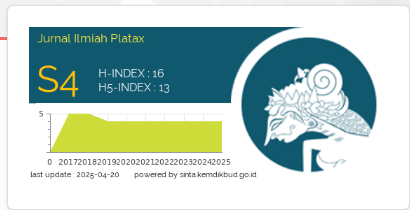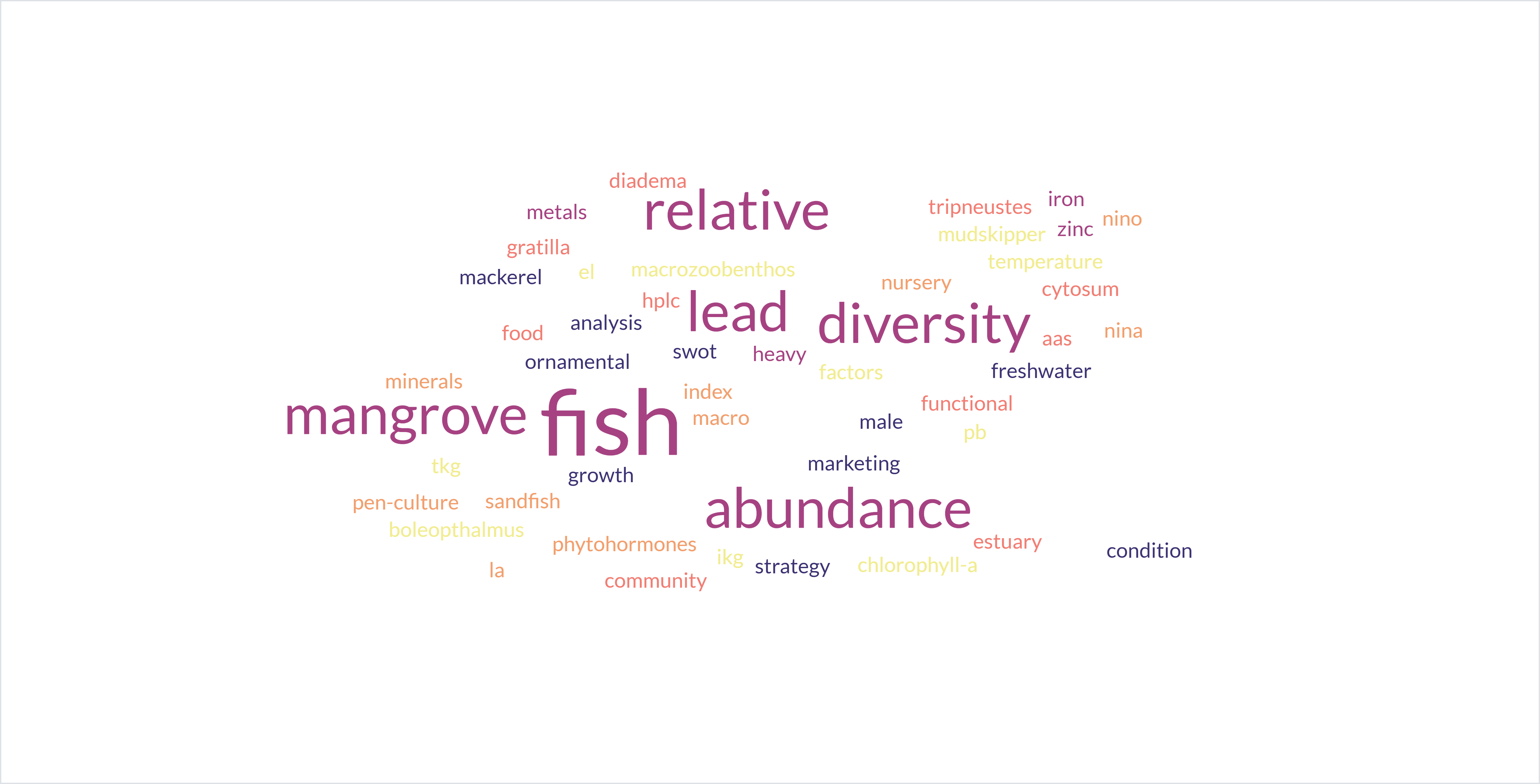Plankton Community Structure In Halmahera Barat Coastal Zone
DOI:
https://doi.org/10.35800/jip.v12i1.53407Keywords:
Indeks keragaman, Indeks keseragaman, Indeks Dominasi, PlanktonAbstract
Research on plankton organisms in supporting aquatic resource management is very important to do. This study aims to see the structure of the plankton community in the coastal waters of West Halmahera Regency. There were 9 sampling sites, namely the waters of Toniku (TO), Tewe (TW), Dodinga (DG), Tuada (TU), Porniti (PR), Payo (PA), Bobo (BO), Sahu (SH), and Ibu (IB). Plankton observations used the Census-SRC method. The parameters observed were abundance, diversity index, uniformity index, and dominance index. The results showed that the highest phytoplankton abundance was found in the TO area, namely 1.7 x 107 cells/m3 and the lowest was 4.1 x 106 cells/m3 in the PR area. The highest phytoplankton diversity index was found in the PR area, namely 2.075 and the lowest was 1.429 in the IB area. The highest uniformity index of phytoplankton was found in the PR area, namely 0.901 and the lowest was 0.624 in the BO and DG areas. The highest phytoplankton dominance index was found in the IB area, namely 0.350 and the lowest was 0.138 in the PR area. The highest zooplankton abundance was found in the DG area at 2.0 x 106 cells/m3 and the lowest was 3.3 x 105 cells/m3 in the IB area. The highest zooplankton diversity index was found in the TU area, namely 1.981 and the lowest was 1.516 in the IB area. The highest uniformity index of zooplankton was found in the IB area, namely 0.942 and the lowest was 0.761 in the DG area. The highest zooplankton dominance index was found in the BO area, namely 0.266 and the lowest was 0.167 in the TU area. The conclusion of this study revealed that the most common type of plankton found was Bacillariophyceae. While the diversity value shows moderate diversity, the uniformity value shows a high level of uniformity, and the dominance value shows low-moderate dominance.
Keywords: Diversity index; Uniformity index; Dominance index; Abundance; Plankton
Abstrak
Penelitian tentang organisme plankton dalam mendukung pengelolaan sumberdaya perairan sangat penting untuk dilakukan. Penelitian ini bertujuan melihat struktur komunitas plankton perairan kawasan pesisir Kabupaten Halmahera Barat. Terdapat 9 lokasi sampling, yaitu perairan Toniku (TO), Tewe (TW), Dodinga (DG), Tuada (TU), Porniti (PR), Payo (PA), Bobo (BO), Sahu (SH), dan Ibu (IB). Pengamatan plankton menggunkan metode Sensus-SRC. Parameter yang diamati adalah kelimpahan, indeks keragaman, indeks keseragaman, dan indeks dominansi. Hasil penelitian menunjukan kelimpahan fitoplankton tertinggi terdapat di kawasan TO yaitu 1,7 x 107 Sel/m3 dan terendah 4,1 x 106 Sel/m3 di kawasan PR. Indeks keragaman fitoplankton tertinggi terdapat di kawasan PR yaitu 2,075 dan terendah 1,429 di kawasan IB. Indeks keseragaman tertinggi fitoplankton terdapat di kawasan PR yaitu 0,901 dan terendah 0,624 di kawasan BO dan DG. Semetara indeks dominansi fitoplankton tertinggi terdapat di kawasan IB yaitu 0,350 dan terendah 0,138 di kawasan PR. Kelimpahan zooplankton tertinggi terdapat di kawasan DG yaitu 2,0 x 106 Sel/m3 dan terendah 3,3 x 105 Sel/m3 di kawasan IB. Indeks keragaman zooplankton tertinggi terdapat di kawasan TU yaitu 1,981 dan terendah 1,516 di kawasan IB. Indeks keseragaman tertinggi zooplankton terdapat di kawasan IB yaitu 0,942 dan terendah 0,761 di kawasan DG. Semetara indeks dominansi zooplankton tertinggi terdapat di kawasan BO yaitu 0,266 dan terendah 0,167 di kawasan TU. Kesimpulan penelitian ini mengungkapkan jenis plankton yang paling banyak ditemukan adalah Bacillariophyceae. Sementara nilai keragaman menunjukkan karagaman sedang, nilai keseragaman menunjukkan tingkat kesergaman tinggi, dan nilai dominasi menunjukkan dominansi rendah – sedang.
Kata kunci: Indeks keragaman; Indeks keseragaman; Indeks dominansi; Kelimpahan; Plankton.
References
Ardiansyah, Z., Apriadi, T., & Muzammil, W. (2023). Biodiversitas Zooplankton di Perairan Barek Motor, Kota Kijang, Kecamatan Bintan Timur, Kabupaten Bintan, Kepulauan Riau. Jurnal Akuatiklestari, 6, 133-142.
Brown, E. R., Cepeda, M. R., Mascuch, S. J., Poulson-Ellestad, K. L., & Kubanek, J. (2019). Chemical ecology of the marine plankton. Natural Product Reports, 36(8), 1093-1116.
Cahyaningtyas, I., Hutabarat, S., & Soedarsono, P. (2013). Studi analisa plankton untuk menentukan tingkat pencemaran di muara Sungai Babon Semarang. Management of Aquatic Resources Journal (MAQUARES), 2(3), 74-84.
Colebrook, J. M. (1984). Continuous plankton records: relationships between species of phytoplankton and zooplankton in the seasonal cycle. Marine Biology, 83, 313-323.
Faucci, A., Philippoff, J., & Veresan, C. (2019). The Microscopic World of Plankton. Science Scope, 42(5), 51-61.
Fenchel, T. (1988). Marine plankton food chains. Annual Review of Ecology and Systematics, 19(1), 19-38.
Hirai, J., Yasuike, M., Fujiwara, A., Nakamura, Y., Hamaoka, S., Katakura, S., Takano, Y., & Nagai, S. (2015). Effects of plankton net characteristics on metagenetic community analysis of metazoan zooplankton in a coastal marine ecosystem. Journal of Experimental Marine Biology and Ecology, 469, 36-43.
Junaidi, M., Nurliah, N., & Fariq Azhar, F. A. (2018). Kondisi Kualitas Perairan untuk Mendukung Budidaya Lobster di Kabupaten Lombok Utara, Provinsi Nusa Tenggara Barat.
Morales, M., Aflalo, C., & Bernard, O. (2021). Microalgal lipids: A review of lipids potential and quantification for 95 phytoplankton species. Biomass and Bioenergy, 150, 106108.
Sihombing, H. P., Hendrawan, I. G., & Suteja, Y. (2018). Analisis hubungan kelimpahan plankton di permukaan terhadap hasil tangkapan ikan lemuru (Sardinella lemuru) di Selat Bali. Journal of Marine and Aquatic Sciences, 4(1), 151-161.
Vincent, F., & Bowler, C. (2020). Diatoms are selective segregators in global ocean planktonic communities. Msystems, 5(1), 10-1128.
Wahyuningsih, F., Arthana, I. W., & Saraswati, S. A. (2020). Struktur komunitas Echinodermata di area padang lamun pantai Samuh, kecamatan Kuta Selatan, kabupaten Badung. Current Trends in Aquatic Science, 3(2), 52-58.
Wang, J., Yang, M., Ding, Z., Zheng, Q., Wang, D., Kpalma, K., & Ren, J. (2021). Detection of the deep-sea plankton community in marine ecosystem with underwater robotic platform. Sensors, 21(20), 6720.
Williams, O. J., Beckett, R. E., & Maxwell, D. L. (2016). Marine phytoplankton preservation with Lugol’s: a comparison of solutions. Journal of Applied Phycology, 28, 1705-1712.
Yang, T., Chen, Y., Zhou, S., & Li, H. (2019). Impacts of aerosol copper on marine phytoplankton: A review. Atmosphere, 10(7), 414.
Yuliana, Y. (2014). Keterkaitan Antara Kelimpahan Zooplankton dengan Fitoplankton dan Parameter Fisika-Kimia di Perairan Jailolo, Halmahera Barat. Maspari Journal, 6(1), 25-31.
Downloads
Published
How to Cite
License
Copyright (c) 2024 Tamrin, Joshian Nicolas William Schaduw, Haryani Sambali, Adnan Sjaltout Wantasen, Desy Maria Helena Mantiri, Rene Charles Kepel, Winda Mercedes Mingkid, Ockstan Jurike Kalesaran, Nurhalis Wahidin, Muhammad Aris

This work is licensed under a Creative Commons Attribution-NonCommercial 4.0 International License.
COPYRIGHT
Authors who publish with this journal agree to the following terms:
Authors hold their copyright and grant this journal the privilege of first publication, with the work simultaneously licensed under a Creative Commons Attribution License that permits others to impart the work with an acknowledgment of the work's origin and initial publication by this journal.
Authors can enter into separate or additional contractual arrangements for the non-exclusive distribution of the journal's published version of the work (for example, post it to an institutional repository or publish it in a book), with an acknowledgment of its underlying publication in this journal.
Authors are permitted and encouraged to post their work online (for example, in institutional repositories or on their website) as it can lead to productive exchanges, as well as earlier and greater citation of the published work (See The Effect of Open Access).






































